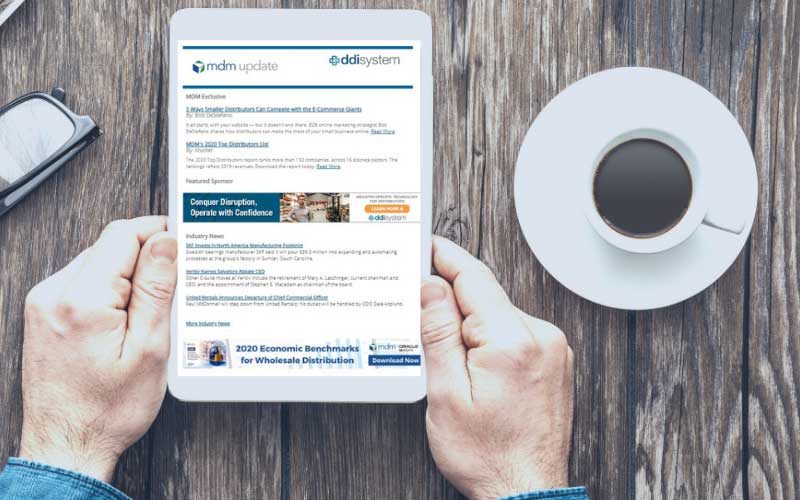Welcome to the Logistics Liaison, a monthly briefing on the top supply chain issues in wholesale distribution. I’m Vesna Brajkovic, Senior Editor at MDM and a former transportation reporter. Each month, I’ll dive into a logistics/transportation topic and dip into my industry contacts to help break down how it affects your business. This month: port strikes.
What remains certain about the nature of the supply chain is that volatility is a constant business condition. The next threat of disruption — whether a natural disaster, cyberattack or another union labor dispute — is imminent.
Since the inception of the idea for this article on supply chain disruptions, there have already been three major events. It started with a potential labor strike of Canada’s largest freight railroads, then came the Gulf/East Coast port strike, and, now, as we publish this, distributors are accessing and recovering from the impact of Hurricanes Helene and Milton.
While the strike was short-lived, lasting three days before the dockworkers’ union and port operators agreed to a wage hike, the potential (and expectation) for the shutdown to last a week or more drew alarm.
Many businesses, especially those who rely on imports through the 36 affected ports, were bracing for the worst-case scenario. A prolonged work stoppage would have:
- increased lead times on imported products,
- raised business costs due to congestion and shipping costs, and;
- inundated West Coast ports due to rerouted shipments
Freight rates were expected to surge. In the weeks before the stoppage, some ocean carriers introduced surcharges with creative descriptions like “local port charge,” which ranged from hundreds to thousands of dollars per container, explained Ashley Craig — a partner at law firm Venable LLP, which has an international trade and logistics group — in late September. Such surcharges were flagged by the Federal Maritime Commission.
Nearly 200 associations, representing every corner of the supply chain from distribution and manufacturing to retailers and farmers, sent a joint plea to the White House, calling for intervention. The National Association of Wholesaler-Distributors’ CEO made several appearances on Fox News.
Brace & Respond: What Distributors Did… and Didn’t Do
In anticipation of the port shutdown, several major distributors across industry segments told NAW they increased their safety stock. Others rerouted containers to the West Coast despite incurring an increase in lead times and business costs.
While the most concerned of the bunch were companies that rely on imports to the Gulf or East Coast ports, even distributors using West Coast ports were bracing for delays as other retailers, manufacturers and distributors preemptively rerouted products to there.
The strike came on the heels of the busiest time of the year for trucking and delivery companies as retailers deliver holiday products. Thankfully, the impact that was predicted never materialized to its fullest extent. (See the section “Rebound & Recovery: Clearing Backlogs”).
Justifying Investment in Resiliency
To explain what factors allow a distributor to weather supply chain shocks, we’ll borrow a simplification on supply chain resiliency from Panos Kouvelis, a supply chain management professor and the director of the Boeing Center for Supply Chain Innovation, a research center at Washington University in St. Louis. To be resilient, a company must have:
- redundancy in resources, and;
- the flexibility to react
Larger distributors (let’s say those with over $80 million in annual revenue) are more likely to have the resources, time, expertise and flexibility to invest in tracking and planning for potential disruptions. By nature, smaller companies are left more reactive.
“For smaller firms… the ability to invest in excess resources needed in the case of the crisis is very hard. It’s hard for them to justify,” Kouvelis said. “And even when it comes down the flexibility, they really depend either on their suppliers or on the customers they serve downstream. Therefore, they have to see what those major players are going to be doing, and how are they going to respond to it?”
“All supply chains aspire to be resilient, but economists and supply chain managers will tell you that we always underinvest in it. It does not seem to pay off, until the strike starts.” — Panos Kouvelis
Many distributors also lean on their suppliers and manufacturers — which are the parties using ports to import raw materials — to plan for and communicate about disruptions downstream. Proactive distributors strive to understand port utilization of key suppliers, its current inventory position and its vendor’s current inventory position.
One building materials distributor told me communication lagged around the port strike.
“I did not receive anything from any manufacturer until this week,” Palmer-Donavin’s Vice President of Product Josh Thompson told MDM on Sept. 27. “I think it is just starting to sink in that this could cause disruption.” The Ohio-based building materials distributor only expected indirect and minor impacts since imports are a small percentage of its business.
Making the Case for Preparedness
Growth, acquisition of market share and maintaining positive cash flow often trump preparedness for unforeseen events for small- to mid-cap organizations, said supply chain consultant Brewster Smith, Colliers’ Senior Vice President of Supply Chain Solutions.
Turning inventory is how distributors make money. In a transactional business, operating on slim margins, there is little room for error, one distributor told me. Distributors must walk the line between preempting shocks to their business and avoiding overestimating demand, leaving inventory sitting around and killing yearly profit.
NAW CEO Eric Hoplin joined MDM Senior Editor Vesna Brajkovic to talk distribution’s response to the port strike on an episode of the MDM Podcast.
The definition of supply chain resiliency is the ability of a company to respond to future shocks, which can be described as low-probability events with significant consequences.
Investing in low probability isn’t always easy. As Kouvelis reminded me: Distributors still have memory of the access inventory many carried over for years following the pandemic. “That’s a lesson that you don’t forget.”
“We want to to strike that balance of not overacting and creating a bullwhip effect.” — Richelle Bisoff
“We want to to strike that balance of not overacting and creating a bullwhip effect, like we saw at lot during the pandemic, but also making sure we understand where there is risk and mitigating that as strategically as possible,” said Border States Vice President of Procurement Richelle Bisoff on the electrical supplies distributor’s own supply chain disruption planning efforts.
Border States is one notable explain of a distributor that learned a lesson from the pandemic, which exposed how fragile the supply chain can be, and used that lesson to strengthen its communication through a monthly “Supply Chain Update.” The Fargo, ND-based distributor works with its suppliers to share updates on material lead times, commodity updates, inflationary pressures and other market trends.
“It comes down to a belief that leaning into those tough conversations is going to drive the most transparency and, ultimately, the best result,” said Bisoff, who plays a role in the monthly update.
It comes down to ownership, she adds. “Not waiting for someone else to come to you with the answers and rather seeking it out, even if it doesn’t come out with a clear outcome or answer.”
Employee-owned Border States was No. 6 on MDM’s 2024 Top Distributors List for electrical, data & security products distributors.
Rebound & Recovery: Clearing Backlogs
Affected ports will take weeks to recover, NRF Vice President for Supply Chain and Customs Policy Jonathan Gold said in an Oct. 3 news release.
“The surge in imports over the past few months has clearly been the result of contingency imports by wholesalers, retailers and industrial companies in anticipation of the East and Gulf Coast port strike rather than a sudden increase in demand,” Hackett Associates Founder Ben Hackett said. “We may see some short-term congestion on the West Coast but nothing significant, and East Coast delays should be limited.”
Although short-lived, retailers and distributors that brought in cargo early or diverted to the West Coast now face added warehousing and transportation costs.
Freight Impact
The full impact of recent port strikes and hurricane recovery efforts has yet to materialize in freight data (see “Stat Check” below). Without considering its influence on the numbers, rail activity has been steadily growing and trucking conditions, although in the red, are still expected to recover (albeit in a “frustratingly gradual” way, to borrow the words of FTR Vice President of Trucking Avery Vise).
Imports at major container ports should continue at elevated levels this month despite the strike, according to the Global Port Tracker report released by the National Retail Federation and Hackett Associates. The strike did not appear to affect the national totals of TEUs in North America.
The freight industry is still bracing for delays as backlogs clear as supply chain pressure mounts.
“Damage from Hurricane Helene and rising fuel prices due to tensions in the Middle East are adding pressure on supply chains, increasing consumer costs, and complicating economic recovery,” wrote the Association of American Railroads in its monthly rail industry overview.
Stat Check
This section of MDM’s Logistics Liaison includes key indicators which together help gauge the health of the supply chain. Why these stats? Have another indicator related to transportation and logistics on your radar? Contact vesna@mdm.com.
🚛 Trucking: FTR’s Trucking Conditions Index fell back into the negative in July, marking the least favorable freight rates since April. Despite the drop to -5.59 from 0.95 in June, trucking conditions are expected to recover by early 2025.
🚂 Rail: Steady growth in rail activity colored AAR’s Freight Rail Index, which rose 0.4% MoM in September, suggesting sustained demand for goods. Carloads decreased 0.5% YoY to 914,219, with a notable 19.6% YoY increase in grain shipments drug down by the continued decline in coal (down 8.0%) and crushed stone, sand and gravel (7.3%).
🚢 Ports: Most major North American ports (except L.A., Manzanillo, Mexico, and Vancouver) recorded YoY double-digit volume growth in the second quarter. Drewry’s North American Container Port Throughput Index fell slightly MoM to 113.5 points in July but was up 15.2% YoY. NRF’s Global Port Tracker logged about 2.34 million TEUs in August, up 0.9% from July and 19.3% YoY. Forecasted volumes for September and October are projected to be up.
📦 Freight: BTS’s Freight Transportation Services Index increased 1.1% in August MoM, snapping a two month skid. The 1.5-point gain from July (which was revised down 0.6 points to 138.4) was attributed to increases in water, rail carload, rail intermodal, trucking and air freight, while pipeline declined. The Cass Freight Index rose 1.0% in August after a 3.0% increase in July, which followed four straight declines.
🏭 Manufacturing: ISM’s Manufacturing PMI contracted in September for the sixth consecutive month and the 22th contraction in the last 23 months. Thirteen industries contracted, and five grew (petroleum and coal products; food, beverage and tobacco products; textile mills; furniture; and miscellaneous manufacturing.)




